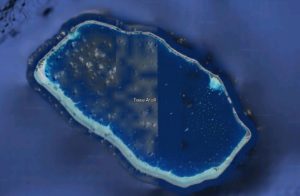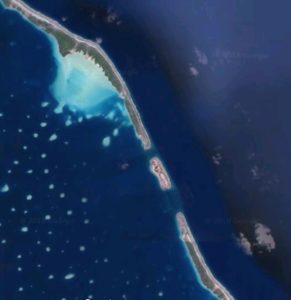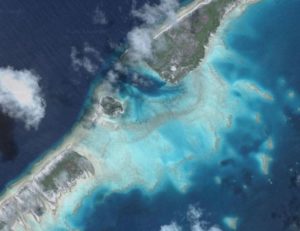 The wind had been relatively quiet the last week, so when we sailed up from Fakarava to Toau we were glad to have some breeze to sail with. Our pass entrance was uneventful and we motored into the pass on the east side with about 3 knots of current and the wind at our backs.
The wind had been relatively quiet the last week, so when we sailed up from Fakarava to Toau we were glad to have some breeze to sail with. Our pass entrance was uneventful and we motored into the pass on the east side with about 3 knots of current and the wind at our backs.
After realizing that the coral on the reefs inside the atoll was mostly dead and not worth diving, we decided to head around to the northwestern side to an anchorage called Anse Amyot. By that time the wind had been blowing a good 15 knots from the east for 3 days, and was forecast to build as the week went on.
The sail to Anse is 23 miles, so we figured we needed 4 hours of daylight to make it safely around before dark. That meant we had to be out the pass by noon or not much later. Low tide yesterday was around 1:00, and we knew from our entrance earlier in the week that slack current was two hours later than that.
We pulled our anchor the first time at 10:00 and motored over to the pass, noticing we had two knots of current as we approached the pass. That meant there was still quite a bit of current going out the pass into wind driven waves from 3 days of an easterly breeze. As we got close enough to see the entrance we found 6′ to 9′ standing waves in the pass. So back to the anchorage we went.
We pulled our anchor the second time at 11:30 and motored around again, noticing that there wasn’t as much current. But again as we approached we decided the waves were just too big to get through and breaking in the middle, so we went back and anchored again.
As we returned again to the anchorage, Hello World was pulling up their anchor to head out. Because they sail much faster, they could leave later and still get to the other anchorage before dark. We watched them through the binoculars and when we saw the first third of their boat come out of the water as they hit the pass it looked absolutely frightening. They’re 13′ longer than us and I’d guess they weight about 7 tons more than us, and they were taking a pounding. Brit called after they were clear and said it was really bad, and they wouldn’t do that again.
Knowing the wind was only going to build as the week went on, we started wondering how and when we were ever going to get out of there. We really felt like we were going to be trapped in Toau. There was a high tide in the morning around 6:00, so we decided we would go over with the dinghy and watch it and see how it looked and if the waves ever laid down.
Just as nightfall approached we saw lights coming into the lagoon through the pass. There was just enough daylight to see through the binoculars that the boat wasn’t bouncing at all, and it looked like the standing waves were gone. We checked our watches and noted the time relative to the approaching evening high tide.
After checking the weather and knowing the wind was going to get worse, we decided to get up this morning and make a run for it at first light. If we had the anchor up at daybreak we could be out to the pass at the same time relative to the high tide as the boat was that came in.
One of the dangers with breaking waves on your boat is losing things tied to the boat. Rob added 3 extra lines to the dinghy, which we tie onto the bow, lashing it to the bow cleats in front and rails in the back. We took all the empty fuel jugs, fenders and everything else inside the boat. From the cockpit we gathered everything that wasn’t tied down and put it below. We put on our harnesses and clipped ourselves in and headed out.
The primary danger with taking breaking waves is getting sideways to them and getting knocked down. So the most important thing to do is to keep from letting them push the bow down and continue powering into them. As we approached the pass we saw what looked like a clear path on the left side where there was less outgoing current. We headed for the left side, but as we got closer the waves started breaking there, too. Then the right side looked clear, so we headed across to the right side of the channel.
 This pass is only about 200 yards wide and 25 feet deep, with reefs on both sides. As we approached the right side the waves started to get steeper, and suddenly we were in it. We hadn’t gotten far enough to the right and had to turn out into the waves to keep from getting broadside to them and knocked over.
This pass is only about 200 yards wide and 25 feet deep, with reefs on both sides. As we approached the right side the waves started to get steeper, and suddenly we were in it. We hadn’t gotten far enough to the right and had to turn out into the waves to keep from getting broadside to them and knocked over.
We took three breaking waves about 10 seconds apart, the first being just forward of the beam on our port side. As it pushed the bow down I steered as hard as I could to turn us back into it and we immediately took another one over the bow. We both saw it coming, and Rob was lucky to have a dodger to duck under. I took it right in the face. Again I had to turn into it, but the third one broke behind us.
We could see that we were going to get very lucky and got outside the big ones very quickly. After that it was a quick sigh of relief and steering through the huge rollers for another 45 minutes to get clear of the slop created by the pass.
We could see a small ship approaching the pass from Fakarava as we exited. We watched them motor toward the pass about 45 minutes after we had gone through. The boat was about 150′ long, and looked like the local supply ship. They got just close enough to see the pass and turned around and headed back to Fakarava. Rob was going to call them on the VHF and heckle them a bit, but couldn’t remember all the Monty Python lines for taunting the French. {I really thought it’d be funny to get on the radio, point out we were the little sailboat rolling around in the waves behind them, and offer them advice on getting through. I’ve always liked the Monty Python line “I taunt you”, but stopped when I realized we were in no position to evade flying cows. – Rob}
In all fairness, they were 45 minutes after us, and we wouldn’t have made it out if we had been even 15 minutes later, I’m sure. The only thing that did made it passable for us was taking a course along the edge of the pass. We missed about 90% of the big waves, but the 10% that hit us made up for it. It was a total nail biter the whole time because we know our charts are not 100% accurate down here, and we were between breaking waves in the pass and waves breaking onto the reef.
 So here we are now in a beautiful anchorage on the northwest side of the same atoll with our friends from Tasmania on Warrior, and of course Hello World. This pass is not exposed to the easterly winds, so while we feel a nice breeze, there are no waves at the pass and the wind waves from the atoll break on the reef in front of us. We’re planning on leaving at first light for Tahiti, but are tempted to stay and do some diving with Robin and HW tomorrow.
So here we are now in a beautiful anchorage on the northwest side of the same atoll with our friends from Tasmania on Warrior, and of course Hello World. This pass is not exposed to the easterly winds, so while we feel a nice breeze, there are no waves at the pass and the wind waves from the atoll break on the reef in front of us. We’re planning on leaving at first light for Tahiti, but are tempted to stay and do some diving with Robin and HW tomorrow.
From here it’s about 220 miles to Tahiti. If we leave at first light and can manage 7 knots consistently we can get in with only one night out at sea. We think we’ll have about a knot of current with us and pretty good wind, so we should be able to pull it off.
Teresa